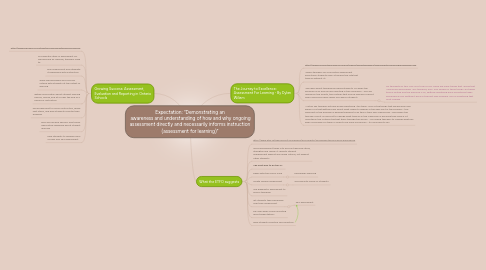Expectation: “Demonstrating an awareness and understanding of how and why ongoing assessment directly and necessarily informs instruction (assessment for learning)”
by Tiana Mangione


1. Growing Success: Assessment, Evaluation and Reporting in Ontario Schools
1.1. http://www.edu.gov.on.ca/eng/policyfunding/growSuccess.pdf
1.2. As essential steps in assessment for learning and as learning, teachers need to:
1.3. plan assessment and integrate it seamlessly with instruction
1.4. share learning goals and success criteria with students at the outset of learning
1.5. gather information about student learning before, during, and at or near the end of a period of instruction
1.6. use assessment to inform instruction, guide next steps, and help students monitor their progress
1.7. give and receive specific and timely descriptive feedback about student learning
1.8. help students to develop skills of peer and self-assessment
2. The Journey to Excellence: Assessment For Learning - By Dylan Wiliam
2.1. http://www.journeytoexcellence.org.uk/videos/expertspeakers/assessmentforlearningdylanwiliam.asp
2.2. "When teachers do a formative assessment effectively students learn at double the rate that they do without it."
2.3. “We learn about teaching by being students. So when the pressure is on and you are reacting in the classroom - you are relying on the scripts, the routines that you’ve learned of about how classrooms work when you were a student.”
2.3.1. My thoughts on this: This is so true for me. There are many things that I know that I should be doing when I am teaching, and I fully believe in those things...but when time is limited and the pressure is on, getting something done sometimes takes precedence over getting it done in the best way possible. This is something that must change.
2.4. “I often say teachers actually know everything I tell them…One of the things that we became very aware of is that getting clear about what needs to happen is the easy part of the problem - the hard part of the problem is helping teachers to do this in their own classrooms…The reason the teachers find it so difficult to change what they do in the classroom is because they have a lot invested in the routines that get them through the lesson. ..You asking teachers to change what has been successful for them in order to be more successful - it’s very hard to do.”
3. What the ETFO suggests
3.1. http://www.etfo.ca/Resources/ForTeachers/Documents/Assessment%20for%20Learning.pdf
3.2. Good assessment takes into account learning styles, strengths and needs. It reflects student achievement against discussed criteria, not against other students
3.3. The best way to do this is:
3.4. begin with the end in mind
3.4.1. backwards planning
3.5. create flexible assessment
3.5.1. according to needs of students
3.6. use diagnostic assessment to inform teaching
3.7. let students take ownership over their assessment
3.7.1. self-assessment
